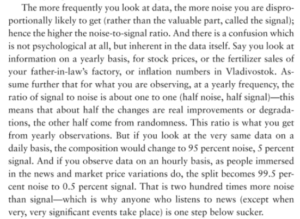Business & Money
Warren Buffet is famously quoted as saying that it’s important to be “fearful when others are greedy and greedy when other’s are fearful.” When people are greedy, demand is high and prices go up. Thus it’s easy to overpay for things. Inversely, when people are fearful, demand is low and prices fall. This can lead to good value buying opportunities.
Safe to say that people are greedy right now. The markets are frothy.
If you look at Berkshire’s financials, their market cap is north of $410 billion. Almost a quarter of that is held in cash and other short-term investments. This ratio of cash to value is really high. When the inevitable correction comes, they’ll willing and able to acquire good business on the cheap.
Human Progress
One of the side effects of technological improvement has been an ever increasing access to information. You can whip out your smartphone and get the answer to any question you might have.
While this is great for many reasons, it’s also terrible at the same time. Specifically, it makes is much harder to differentiate signal vs noise. I constantly have to remind myself of this when it comes to investing. The tendency is to want to check my portfolio on a daily basis hoping for a quick shot of dopamine whenever I see a green arrow pointing up. But, daily stock performance is guaranteed to be more noise and less signal.
No one puts the signal v noise discussion in better context than Nassim Nicholas Taleb in his great book Antifragile: Things That Gain From Disorder. Here’s an excerpt:

Philosophy
A few weeks ago I needed to visit a jewelry store. I pulled out my phone, typed in “jewelry store” in Google Maps and viola, there were 5 stores within a ten block radius. I chose one and was on my way. As I neared my destination, the streets become increasingly packed with people. I probably should have picked a store that was NOT in the middle of a high traffic area of Manhattan during rush hour.
This got me thinking about maps in general, and how deficient they are. The map I looked at on my phone showed me a grid of NYC streets. It didn’t show may how many people might be in my target area during a specific time of day. Had I been a tourist, I may have jumped in a cab, only to find out that the subway would have been a more efficient means of transportation.
If you’re a city planner, maps of sewage systems and electrical lines would be equally, if not more important than ones showing street names. Or perhaps you want to consider a map of real estate values.
On an even larger scale, think about the map of the entire world. The first problem is that trying to represent a spherical object like a planet on a flat piece of paper will immediately cause problems. Shapes and sizes will inevitably be distorted. Africa, for example, would have to be 13-14x the size it usually appears on world maps.
Zoom out even further, a map of the solar system is actually a pretty ridiculous representation. It’s as if distance and size are of menial importance. It’s only real value is in gleaning the order of the planets from the sun.
All this is not to say that maps are useless tools in understanding the world, but any one map will always have serious limitations. You have to consider the subjective perspective of the creator, the mediums it’s presented on, when it was made, and many many other facets.
My Latest Discovery
I’ve recently switched to using Google Authenticator for all two-factor authentication (2FA). It’s much safer than receiving 2FA codes via SMS because Google Authenticator is not tied to your phone number. If a bad actor hacks a phone system, then can intercept 2FA codes coming in via SMS. One could even port your cell number without you knowing which would allow them to do the same. There has been a spate of recent attacks that have followed this formula so do yourself a favor and get Google Authenticator or something similar that doesn’t rely on your phone number.